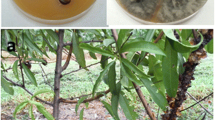Abstract
For the first time in the history of black pepper cultivation, a partly fertile interspecific hybrid having partial resistance to the dreaded disease Phytophthora foot rot was developed through hybridizing Piper nigrum with the wild species Piper colubrinnum. Hybridity of interspecific progenies was established through morphology, anatomy, cytology, and molecular studies. The hybrid, whose chromosome number is 2n = 39, is a triploid hybrid between a tetraploid and diploid species. The hybrid designated as Culture P5PC-1 exhibited distinct anatomical and morphological feature with a large number of long spikes with reduced setting percentage. The RAPD primers OPE 07 and OPG 08 were identified as hybrid specific molecular markers. Functional evaluation revealed partial introgression of genes—responsible for Phytophthora foot rot resistance—into the hybrid. This hybrid is considered as a successful breakthrough for introgression of resistance to the cultivated species Piper nigrum from the wild species Piper colubrinnum.





Similar content being viewed by others
References
Ahmad F, Comeau A (1991) A new intergeneric hybrid between Triticum aestivum L and Agropyron fragile (Roth) Candargy—variation in A. fragile for suppression of the wheat pH—locus activity. Plant Breed 106:275–283
Anand A, Sujatha VS, Suresh Babu KV, Nybe EV (2000) Chromosome number in Piper spp Indian J Pl Genet Resour 13:183–185
Annual report 2004–2005. Indian Institute of Spices Research, Calicut, 20
Chaudhary BR, Joshi P (2001) Genetic diversity in advanced derivatives of brassica inter specific hybrids. Euphytica 121:1–7
Choudhary SS, Choudhary P (1989) Schedule of fertility test in pollen grains. In: Laboratory techniques in cytogenetics and plant breeding. 22 pp
Doyle JJ, Doyle JL (1990) Isolation of plant DNA from fresh tissues. Focus 12:13–14
Gross P, Julius C, Schmelzer E, Hahlbrock K (1993) Translocation of cytoplasm and nucleus to fungal penetration sites is associated with depolymerization of microtubules and defense gene activation in infected, cultured parsley cells. EMBO J 12:1735–1744
Howards HW (1939) The size of seeds in diploid and autotertraploid Brassica oleracea L J Genet 38:325–340
Johansen D (1940) Plant microtechnique. McGraw Hill Book Co. Inc., New York, pp 38–138
Jose J, Sharma AK (1984) Chromosome studies in the genus Piper L J Indian Bot Soc 63:313–319
Kimber G (1984) Technique selection for the introduction of alien variation in wheat. Z pflanzenziichtg 92:15–21
Krishnamoorthy KV (1988) Methods in plant histochemistry. S.Viswanathan Pvt. Ltd., Madras
Mathew PM (1958) Studies on Piperaceae. J Indian Bot Soc 37:165–171
Matsubayashi M (1962) Studies on the species differentiation in Solanum, sect. Tuberosum, VIII. Genetic relationships between S. demissum and certain diploid Solanum species. Rep Kihara Inst Biol Res, Yokohama 13:57–68
Menancherry AJ (1993) Comparative anatomical studies on five species of Piper L. (Piperaceae). Thesis, University of Calicut, India
Murty YS (1959) Studies in the order Piperales. IV. A contribution to the study of vegetative anatomy of three species of Piper. In: Proceedings, National Institute of Science, India, vol 25, pp 31–38
Nishiyama I, Sarashima M, Matsuzawa Y (1991) Critical discussion on abortive inter specific crosses in Brassica. Plant Breed 107:288–302
Pal P (1961) development studies: VII: the origin and courses of the vascular systems in the shoot apices of six species of the genus Piper (Piperaceae). Bull Bot Soc (Bengal) 15:17–29
Prakash S (1973) Haploidy in Brassica nigra Koch. Euphytica 22:613–614
Ravindran PN (1990) Studies on black pepper and some of its wild relatives. Thesis, University of Calicut, Calicut, India
Ravindran PN (2000) Botany and crop improvement. In: Ravindran PN (ed) Black pepper. Harwood publications, The Netherlands, pp 23–143
Roy NN (1984) Inter specific transfer of Brassica juncea type high blackleg resistanceto B. napus. Euphytica 33:295–303
Sarma YR, Premkumar T (1988) Diseases of black pepper. In: Proceedings of the International pepper community workshop on black pepper diseases, October 27–29, Goa, India. National Res. Centre for spices, Calicut, Kerala, pp 55–103
Sasikumar B, Chempakam B, George JK, Remashree AB, Devasahayam S, Dhamayanthi KPM, Ravindran PN, Peter KV (1999) Characterization of two interspecific hybrids of Piper. J Hortic Sci Biotechnol 74(1):125–131
Acknowledgments
We extent our sincere thanks to Kerala State Council for Science Technology and Environment, India, who funded the project. Thanks are also due to Dr. Gurinder Jit Randhawa, NBPGR, New Delhi, India, Dr. Rajmohan, College of Agriculture, Vellayani, Kerala, India, and Dr. Luckins C Babu College of Forestry, Kerala Agricultural University, India for rendering the lab facilities.
Author information
Authors and Affiliations
Corresponding author
Rights and permissions
About this article
Cite this article
Vanaja, T., Neema, V.P., Mammootty, K.P. et al. Development of a promising interspecific hybrid in black pepper (Piper nigrum L.) for Phytophthora foot rot resistance. Euphytica 161, 437–445 (2008). https://doi.org/10.1007/s10681-007-9602-4
Received:
Accepted:
Published:
Issue Date:
DOI: https://doi.org/10.1007/s10681-007-9602-4




